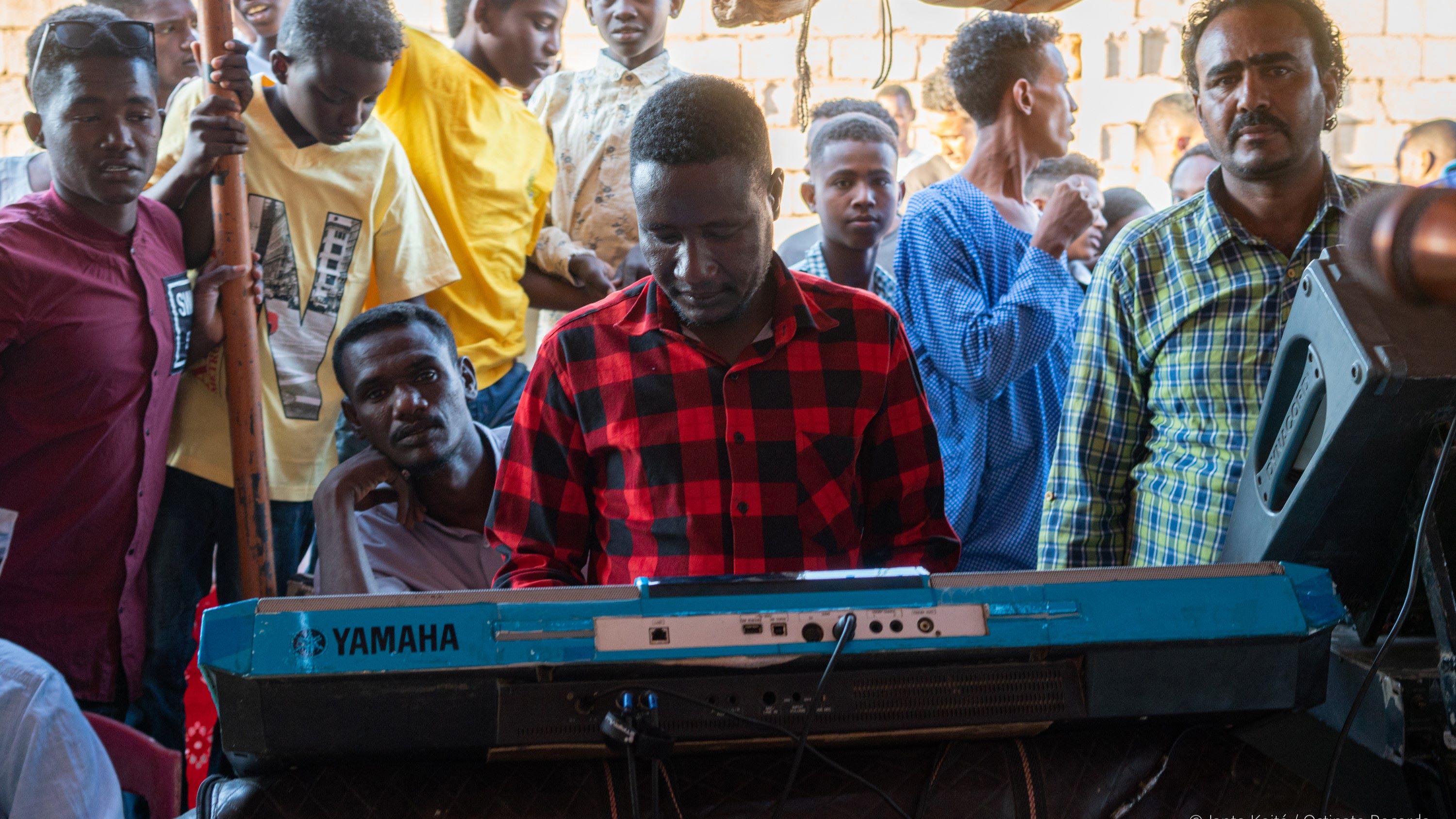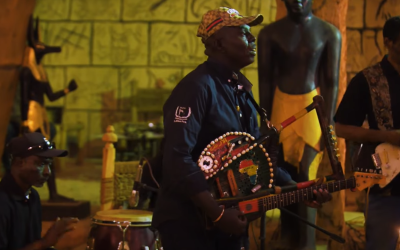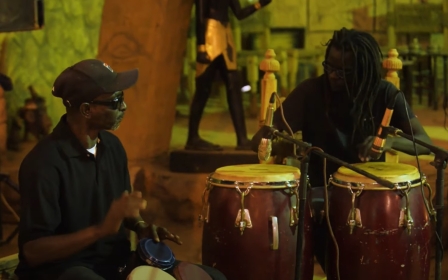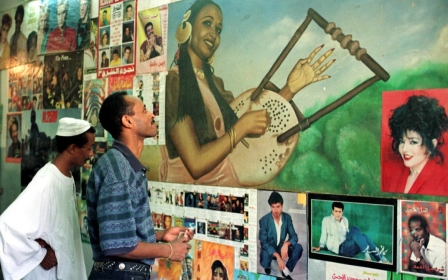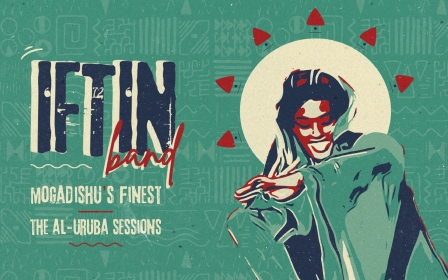Electronic Jaglara: The ‘cosmic’ dance music rocking rural Sudan

On the outskirts of Khartoum at a groom’s henna celebration, an unassuming forty-something man leads a crowd into a trance-like state with virtuosic stabs on his Yamaha.
Inside a tent equipped with a modest sound system, men raise kaskara swords as they sway to magnetic rhythms. One whips out a pistol in the middle of the dancefloor before firing into the air. Soon a mosh pit develops and the simmering rowdiness progresses into a scuffle.
The man responsible for this cacophony is known as Jantra and his dexterous fingers swirl endlessly over his blue keyboard, indifferent to the scene unfolding before him.
This is a glimpse of a Jaglara party unknown to most of Sudan, let alone the world.
“I’ll never forget it,” Vik Sohonie, founder of indie label Ostinato Records, tells Middle East Eye. “It was raucous, infectious energy – it was a club.”
Stay informed with MEE's newsletters
Sign up to get the latest alerts, insights and analysis, starting with Turkey Unpacked
The high-octane beats recall legendary Syrian musician Omar Souleyman’s frenzied dabke, but the otherworldly dance music of Jaglara (roughly translated as improvisation) reveals a brew uniquely Jantra’s and of his region, where traditional Sudanese melodies and rhythms are fused with ethereal synth keys to craft sublime frequencies only his Yamaha can conjure up.
The style is showcased in Ostinato’s latest release, Synthesised Sudan: Astro-Nubian Electronic Jaglara Dance Sounds from the Fashaga Underground, making Jantra’s hitherto obscure music now accessible to dancefloors worldwide.
To Sohonie, it's groundbreaking. "What Jantra is doing with the synthesiser is what no one else in the country is doing, nor anyone in Africa," he says.
A well-kept secret
From the mid-1970s and well into the 1980s, African artists carved a space out as early pioneers of electronic music.
Artists like Nigerian keyboardist-turned-pastor William Onyeabor with his electro-funk catalogue, Cameroonian Francis Bebey with his experiments in futuristic folk, and Nigerien-Ghanaian Mamman Sani with his dreamy organ-drone projects, all produced cutting-edge recordings for their time.
Africa enjoys thriving electronic music scenes spanning the continent and has bred distinctive dance music styles like Afrobeats (not to be confused with Afrobeat), electro chaabi, Singeli and Amapiano.
Now, Jaglara can fittingly be added to that canon.
Despite living in relative obscurity, Jantra enjoys a massive following in the periphery of eastern Sudan. He has achieved this by creating a sound intimately tied to his land, what Sohonie dubs “Sudanese country music”.
A sharp class divide explains why Jantra’s existence is far off urban society’s radar, given the rural and pious segment he regularly performs for.
Jantra hails from the town of Gadarif in Fashaga, a disputed region that borders Eritrea and Ethiopia. This isolated and conflict-ridden environment was an unlikely wellspring for mesmerising space-age music but it nevertheless caught the attention of his community, eventually cementing cult figure status for him.
Finding the sound
Sohonie describes how playing music was a necessity for Jantra in order to support his family. His self-taught keyboard chops were honed over two decades, and as his stature grew he began to be invited to various events, earning his bread through performances at weddings, henna events, and the street party circuit.
Founded in 2016, Sohonie’s Grammy-winning imprint has made a habit of reissuing and releasing raw and hidden gems from Sudan and the Horn of Africa. Much like last year’s album Beja Power! traced its inception to a fortuitous TikTok search, the Synthesised Sudan story followed a similar script.
During the first lockdown in 2020, Sohonie had been sifting through an extensive range of Sudanese music on YouTube to train the algorithm to uncover new artists, when he stumbled upon Jantra’s lively performances. Some had more than a million views; however, he noticed the comment sections were exclusively in Sudanese Arabic.
With contacts fostered over multiple years in Sudan, Sohonie made some calls to track down the synth maestro. After a year of unsuccessful plans to meet passed by, Sohonie and label producer Janto Koite finally made it to Khartoum in 2021 to record Jantra – a moniker meaning “craziness” in a nod to his persona and sound.
A man of few words, the enigmatic Jantra maintains a hermetic lifestyle. Despite having a brother who runs a mobile phone shop, Jantra doesn’t own a phone, making him notoriously difficult to get a hold of.
“We bought him a phone, then he lost it. We got him another and he lost it again,” Sohonie laughs. He mentions how Jantra can go missing for months, and displays the traits of “a classic creative genius”.
‘Pimp your synthesiser’
Synthesisers have always played a big role in Sudan. The history of electronic music in the country stretches back to the early 1980s when musicians began experimenting with synths and drum machines.
Today, it is common to find them at weddings across the country. Among the urban youth, Zanig is a popular style of synth-driven music at parties and clubs.
Dubai is currently the keyboard pipeline to Sudan, where typically one or two Sudanese individuals buy a shipload and freight it back. As a result, supply is not always steady and new models can take a year or two to arrive.
This makes preserving old models crucial. A massive “keyboard graveyard” in Omdurman market near the capital underscores that significance: it is here where Jantra’s signature Yamaha and countless others have been modified by keyboard mechanics to suit Sudanese polyrhythms.
“Synths are not tuned to play Sudanese scales or rhythms, so you have to gut and reprogram them,” Sohonie explains. “It’s kind of like taking them to a car chop shop: you pimp your synthesiser.”
Alongside his own customised tweaks and a USB stick holding select tunes, Jantra’s keyboard is adapted to precise melodies and the driving Sera rhythm, a traditional Sudanese rhythm that underpins all tracks on the album.
Prior to recording, the label planned for an album devoid of a dusty or obscure aesthetic. “We wanted it to sound modern and be a danceable EDM [electronic dance music] record,” Ostinato producer Koite tells Middle East Eye.
However, it quickly became apparent that Jantra was not someone you could sit down in a studio to conventionally record.
Without any songs, he effectively freestyles and live-produces his 155-168 beats per minute music while tethered to the reaction of an audience. “He plays when the crowd is feeding him energy. The studio killed his vibe – there was no feedback,” Sohonie says.
This presented a problem: How would they reproduce Jantra’s unfiltered improvisations to create a structured album? To do so, Ostinato forged an innovative approach they called a “hybrid reissue contemporary album”.
The idea was to merge the scant amount of Jantra’s early cassette and digital recordings with the new sessions played at weddings and private gatherings that the Ostinato team followed him to.
Koite devised a technique where he extracted the individual melodies, patterns and MIDI data from Jantra’s gigs and combined it with the older recordings.
“It seemed like nobody else had done this before,” Koite says. It was a time-consuming process, as each individual audio track had to be recorded for the whole length of a Jantra session.
Taking account of how futuristic Jantra’s music sounded, Koite decided the production approach should be too, so he employed AI tools for extraction and mixing.
'Synths are not tuned to play Sudanese scales or rhythms, so you have to gut and reprogram them'
- Vik Sohonie, founder of Ostinato Records
It was eventually distilled into 10 tracks that comprise the album, the first professional attempt to capture the transcendental vibrations of the Jaglara underground.
Meanwhile, the album’s artwork incorporates an Afro-futurist aesthetic. Designed by visual artist Mahammed Elmekki, who like Jantra is also from Gadarif in Fashaga, Elmekki tells MEE he wanted the imagery to grasp Jantra’s spirit with “how I, as a Sudanese, experience our own music”.
The result is the contrast of ancient Nubian pyramids beside futuristic buildings; the celestial and the terrestrial. Lips pursing a cigarette, Jantra’s hovering head is split in half, as if to reveal the dualism of his sonic universe.
The future of music is Fashaga
Unfortunately for Jantra, the political situation in Sudan made it hard for him to perform as often outside of his hometown. Hardly a week after Ostinato announced the record, war broke out again in April.
Keeping with his imprint’s audio-political ethos, Sohonie argues the recording is an example of how the hottest electronic music today is less likely to come from the epicentres of New York, Berlin or London, nor even African hubs like Johannesburg or Lagos – but the rural heartlands of the global south.
“People always assume electronic music is a soundtrack of urban modernity, so it has to be from big capital cities,” says Sohonie.
“But it’s not. The most innovative music is being made in places detached from the international order, [relatively] untouched by globalisation.”
The belief is that global electronic music is moving in a direction that will be defined less by the West and major urban centres, and more by remote regions at the nexus of multiple borders like Fashaga.
“There are a lot of Jantras, it’s just that no one knows about them,” he says. “If you want to find where the future of music is going to be made, you have to go to the Fashagas of the world.”
Middle East Eye delivers independent and unrivalled coverage and analysis of the Middle East, North Africa and beyond. To learn more about republishing this content and the associated fees, please fill out this form. More about MEE can be found here.


